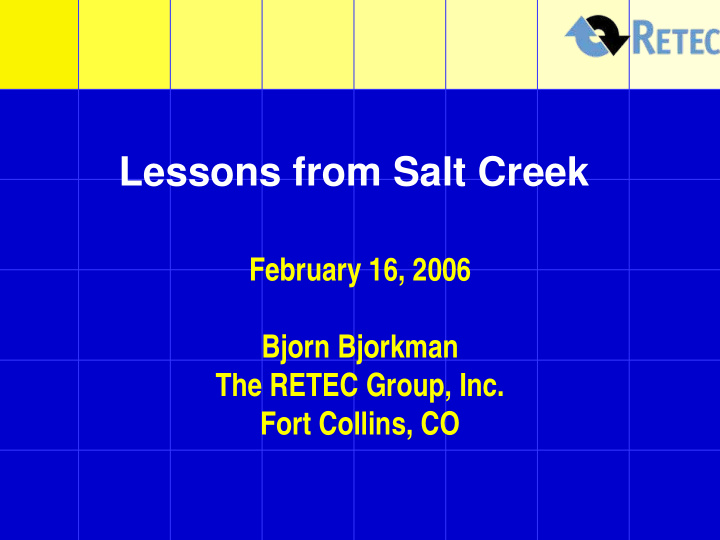



Lessons from Salt Creek February 16, 2006 Bjorn Bjorkman The RETEC Group, Inc. Fort Collins, CO
Background • In 2003 and 2004 prepared UAA for Salt Creek and sections of Powder River • In support of a site specific water quality criterion for chloride • In cooperation with PRCD Section 319 watershed grant • UAA evaluated water quality, livestock use, wildlife, fisheries, and aquatic life
Salt Creek • Originally intermittent creek • Has received produced water from Salt Creek, Teapot Dome and smaller fields for 75 years • Since 1990 year round flows of 13-15 cfs • Almost all base flow in creek is produced water • During late summer Salt Creek contributes up to 90% of flow in Powder River
Meadow Powder River Creek field Salt Creek field Salt Creek Teapot Dome field I-25 Salt Creek upstream of discharges
Lesson 1: Livestock Use • Interviewed and got written statements from ranchers with Salt Creek frontage • All stated that they use and are dependent on Salt Creek for watering their stock • Few alternative water sources available • Ranchers indicate water is excellent for their cattle and sheep (also open in winter, lower salts in summer) • Loss of Salt Creek water would force a reduction in herd size for all ranchers � economic loss
Lesson 2: Wildlife • Salt Creek used by area wildlife as source of food, shelter, and water with no ill effects • Resident fish assemblage matches what would be expected for the region (Wyoming Warm Water Assessment) • Diverse aquatic life community present (Wyoming Beneficial Use Bioassessment) � Produced water in Salt Creek does not result in • impairment to aquatic life, and is a critical resource to wildlife
Sulfates in Powder River 1800 1600 1400 1200 1000 800 600 Maximum 400 Mean 200 0 Minimum Upstream of Salt Interesting aside: South Fork Creek Downstream of of Powder River ranges from Salt Creek 1300 to 2100 mg/L
Sulfates in Salt Creek 15000 14000 13000 12000 11000 10000 9000 8000 7000 6000 5000 4000 3000 Maximum 2000 1000 Mean 0 Minimum Above discharges In Salt Creek Below field discharges
Sulfates • Natural waters not affected by produced water routinely exceed 500 mg/L and may exceed 2000 mg/L sulfates • Smaller intermittent streams may reach much higher (up to 14,000 mg/L recorded)
Sulfate and TDS Toxicity • Concentrations observed in Salt Creek which do not result in any negative effects on livestock or aquatic life: � Salt Creek ABOVE discharges � Sulfates 250-14500 mg/L (average 4700) � bad water � TDS 590-25100 mg/L (average 8040) � bad water � Salt Creek BELOW discharges � Sulfates 870-1700 mg/L (average 1220) � good water � TDS 3240-5040 mg/L (average 4030) � good water
Barium • Reviewed scientific literature on barium toxicity to livestock and wildlife • Barium not generally considered a significant toxicant • U.S. lacks nationally • Canada recommended recommended levels: livestock levels: � e.g. NAS 1974 or CAST 1974 � 100 mg/L for livestock � State Ag Extension Services ( Agriculture and Agrifood 10 mg/L Canada 2000 ) � Recent summary (Beede 2005) notes 10 mg/L as � But Ontario 300 mg/L, British “possible (health) problems Columbia 5 mg/L based on scientific literature and field experience” [for dairy cattle]
Summary • Natural sulfate concentrations are high and often higher than the discharges • No evidence of negative effect on livestock, wildlife, fisheries, or aquatic life from discharged PW to Salt Creek and in Powder River • Use of creek with PW highly beneficial to ranchers as resource for livestock
Aquatic Life SALT POWDER POWDER MEADO CREEK SALT CREEK (DISCHARGE UPSTREAM DOWN- W SALT CREEK (LOWER) (UP- AREA) OF SALT STREAM OF CREEK STREAM) CREEK SALT CREEK % REF- REF- comparison 104% 90% 115% 115% 117% 84% ERENCE ERENCE to reference REF- REF- Conclusion EQUIV EQUIV EQUIV EQUIV EQUIV EQUIV ERENCE ERENCE Primary Criteria Assessment Impairment REF- 100% BASELINE 47% 53% 93% 93% 93% 94% Analysis ERENCE MODERATE MODERATE REF- Conclusion EQUIV BASELINE EQUIV EQUIV EQUIV UNIMPAIRED REDUC- REDUC- ERENCE TION TION
Fisheries Salt Creek Fish Survey 2003-2004 (conducted by WGFD and private consultants) Warm Water Fish Species Comment Assessment Flathead Chub, Plains Minnow, Expected and Sand Shiner, Fathead Populations appear to be thriving in Observed Minnow, Plains killifish, all areas of Salt creek Black Bullhead Expected yet not Common Carp Missed by few Observed Not Expected yet Green Sunfish, Longnose Sunfish is a release, others more Observed Dace, Creek Chub typical of mountain streams Not Expected and Not Many large river and/or Sturgeon Chub is an interesting Observed rocky/clear stream fish case In spite of salty (TDS=3200-5000 ppm) water…
Recommend
More recommend